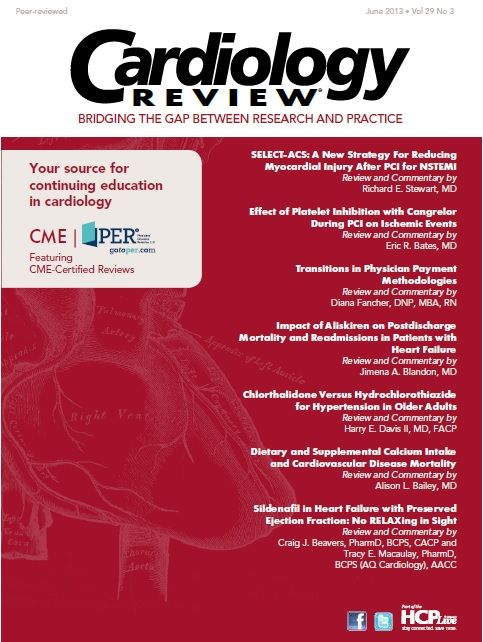Publication
Article
Cardiology Review® Online
News & Trends
Physicians: Draw a Clear Line Between Professional and Social Life
The American College of Physicians and the Federation of State Medical Boards (FSMB) have issued updated recommendations for online contacts with patients, saying that physicians should show restraint when using social media to contact patients (Annals of Internal Medicine, April 16, 2013).
As patient—physician interactions extend into the digital sphere, there are both opportunities and challenges to address. The recommendations suggest that there be a clear line between professional life and social life to avoid the potential dangers concerning confidentiality, replacement of faceto- face or phone interaction, and ambiguity or misinterpretation of digital interactions. The recommendations encourage physicians to strive for a balance between harnessing opportunities presented by use of the technology and being aware of its challenges. Being in touch online should not come at the expense of professionalism.
Among the recommendations made in the guidelines:
• Text messaging should not be used to transmit medical information except when there is patient consent; even with consent, however, extreme caution should be used.
• Patients should not be contacted or “friended” through personal social media such as Facebook.
• When contacted via e-mail or other electronic communications for medical advice from someone who has had no previous contact with the physician, caution and careful judgment must be exercised. Physicians should usually encourage the correspondent to schedule an appointment in the office or go to the nearest emergency department if the situation is urgent.
The new recommendations include discussion of the benefits, pitfalls, and safeguards for potential online interactions with patients, and maintaining professional boundaries. Among the other suggestions, the guidelines caution that medical trainees be careful about what they post online in order to avoid damage to their future careers.
Summing up, Dr. Humayun Chaudhry, president and chief executive officer of the FSMB, noted, “It is important for physicians to be aware of the implications for confidentiality and how the use of online media for nonclinical purposes impacts trust in the medical profession.”
To see the guidelines, visit: http://annals.org/article. aspx?articleid=1675927.
FDA Approves Drug for Urgent Warfarin Reversal in Acute Major Bleeding
The FDA approved Prothrombin Complex Concentrate, Human (Kcentra), a first-inclass therapy for urgent vitamin K antagonist (VKA) anticoagulation reversal in patients with acute major bleeding. Previously, the only option for reversing warfarin and other VKA anticoagulants was plasma.
Kcentra is administered in a significantly lower volume than plasma at recommended doses, providing an alternative for those patients who may not tolerate the volume of plasma required to reverse VKA anticoagulation.
Kcentra’s approval was based on the results of a randomized, controlled Phase III study that included 212 patients. The researchers concluded that Kcentra met all efficacy and safety end points, including the end points of hemostatic efficacy and International Normalized Ratio (INR) reduction compared with plasma.
Kcentra does not work on the thrombin inhibitor dabigatran or the Factor Xa inhibitors, rivaroxaban and apixaban. Kcentra is associated with the occurrence of blood clots when used as indicated, and carries a boxed warning regarding the risk of clots. The warning also explains that patients receiving Kcentra should be monitored for signs and symptoms of thromboembolic events, as both fatal and nonfatal arterial and venous thromboembolic complications have been reported in clinical trials and post marketing surveillance.
Kcentra is a product of CSL Behring.
EHRA Presents Guide to New Oral Anticoagulants
The European Heart Rhythm Association (EHRA) has issued a “Practical Guide” focusing on the use of the new oral anticoagulants (NOACs) as an alternative to vitamin K antagonists to prevent stroke in patients with nonvalvular atrial fibrillation (AFib). There is, to date, little guidance on specific clinical situations in which NOACs are used, and there remain many areas where continued research and clinical trials are needed. The guide is the first attempt to create a unified way to address NOACs in this group of patients.
The guide presents 15 specific clinical scenarios, ranging from starting the drugs to treating atrial fibrillation patients with cancer. It presents a practical start-up and follow-up scheme for patients on NOACs, specifications on how to measure the anticoagulant effect of NOACs, drug—drug interactions and pharmacokinetics of NOACs, and how to switch between anticoagulant regimens.
The guide discusses dosing errors, chronic kidney disease, management of bleeding complications, what to do if there is a suspected overdose without bleeding, of if a clotting test indicates a risk of bleeding, and the issue of patients undergoing surgical interventions.
The guide also stresses patient education, patient compliance, and provides a comprehensive table on steps to take in case of bleeding.
To read the guide, visit: http://www.escardio .org/communities/EHRA/publications/noveloral- anticoagulants-for-atrial-fibrillation/Pages/ welcome.aspx.






